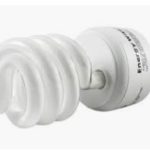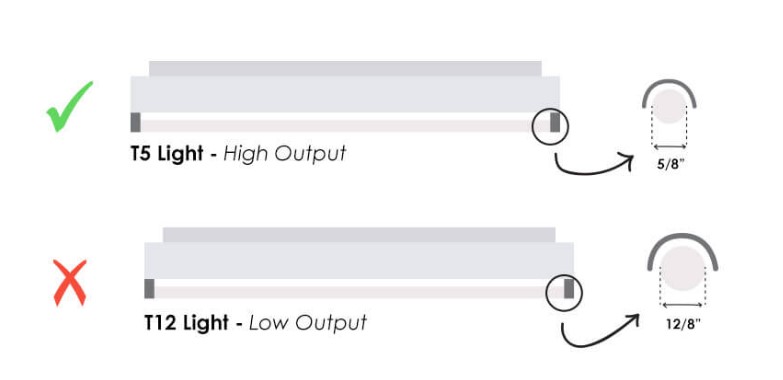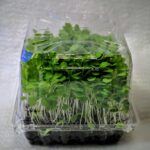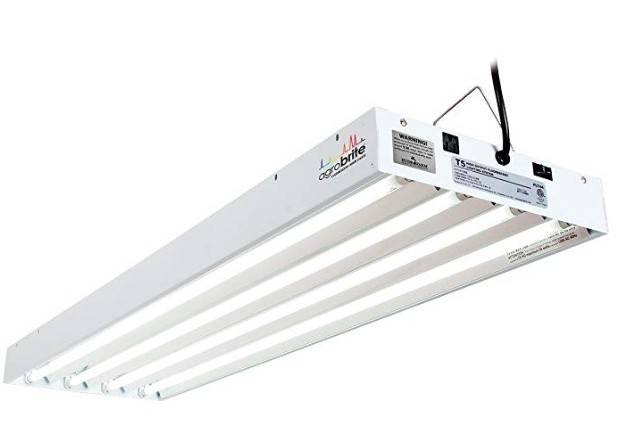This is the beginning of a series of articles covering each type of light commonly used to grow indoor plants. Fluorescent grow lights for indoor plants are not my first pick but they definitely have their place in the “growing” world. Their low cost and energy consumption are huge pluses.
Are All Fluorescent Grow Lights for Indoor Plants Created Equal?

Compact Fluorescent Light
The quick answer is no but more on that in a second. First of all, however, I would like to say a quick word on incandescent bulbs: don’t use them. Incandescents do not have anywhere near the light spectrum of a fluorescent and throw too much heat to be of any use to plants. By the time the plant gets close enough to them to get adequate light, the heat will desiccate and burn them up.
Most large-scale and commercial operations use LED lights because they last longer and emit more light. Fluorescent bulbs are also more fragile, meaning a farmer can incur additional labor costs to maintain them, and that may not be worth the time or money. However, the small-scale or hobby farmer may find fluorescent lights to be an economical choice, especially for low-light plants or plants at a low-light stage of development.
How Fluorescent Lights and What to Look For
All fluorescent lights work in a similar fashion:
- An electric current heats up gas inside the tube, which emits ultraviolet light.
- Meanwhile, a phosphorus coating inside the tube turns that ultraviolet light to visible light.
- A ballast on the back converts the incoming electrical current into a usable form.
You’ll see several numbers on a fluorescent light that give you information about how it works, and help you avoid lights that are too dim.
Tubular lights have a “T” rating that tells you the diameter of the tube. T12 lights have that designation because they have a diameter of 12/8 of an inch or 1.5 inches. These tubes were commonly used in indoor lighting applications, but they’re just not very bright, even with a coating to make them full-spectrum.
T5 lights are narrower than T12s, with a diameter of 5/8 of an inch. Look for a T5 bulb with an additional “HO” rating, which stands for “high output.” That means the ballast has been adjusted to make them even brighter—and for growing purposes, more efficient.

T5 vs T12 Fluorescent Lights
When buying a full-spectrum grow light, you also need to look at the Kelvin rating, which indicates how warm the light is. Fluorescent lights, in general, tend to be bluer but look for a light ranging from 5,600–6,400 Kelvin, which will be indicated on the bulb. On the lower end of that spectrum, the bluer light will give you stockier growth, while the higher rating is great for any kind of vegetation.
Fluorescent lights will also come with a wattage rating to tell you how much electricity the bulb uses, usually 54 watts.
What Colour Lights do Plants Grow Best In?
Plants need the full spectrum of light of they do best with blue and red, depending on the stage of growth they are in. The ideal ration is 5:1 red to blue but don’t forget that red light without the blue light is actually worse than red without the blue.
Blue light is the most important during vegetative growth. Blue is the most important light for plant growth, because it is readily absorbed by chlorophyll and converted into energy through photosynthesis. That said, blue light on its own is not nearly as effective as blue combined with red. And you want far more red than blue light.
Red is the second most important wavelength of light for plants. On its own, red is actually not all that effective, but when combined with blue, it becomes incredibly important. In fact, you want far more red than you do blue, especially during the flowering stages of growth. Adding red light leads to stronger growth with more leaves during vegging and far better fruit and bloom production during flowering. Not only do you get higher yields, but also higher quality yields.
This is one reason why LED lights are much better than fluorescents unless you are only growing leafy green vegetables.
Advantages of Fluorescent Grow Lights
- Very low heat emission, making them safe to place close to plants
- High energy efficiency
- Lower initial costs compared to other types of lighting systems
- Can be placed in different positions to ensure all parts of the plant have adequate lighting
- It is the best type of light for seedlings and clones, due to low radiated heat
- Can accelerate plant growth when used as under-lighting for outdoor plants or in greenhouses
- Fluorescent lights produce the right intensity of light for healthy stems and foliage
- They can produce sufficient energy for flowering (though this is not their strength)
- To reduce energy consumption, the fluorescent light can be used to supplement other types of grow lights
- Fluorescent lights are very simple to use
- They have a natural light spectrum lying between the red and blue wavelengths, which ensures healthy plant growth and productivity
- They are the best for most house plants due to the full daylight spectrum, similar to the sun
- Produced in a wide range of sizes and shapes, which means they can be placed in varying positions, including in close proximity to plants, which adds to the convenience of use
- Come in a range of light colors (warm white, cool white, daylight, etc.)
- Can be hung vertically and horizontally
- Most have a life span of tens of thousands of hours of service
- They have no-glare light which is friendly on the eyes
- Some of the latest fluorescent lights can give more than 90% of the solar spectrum
- Fluorescent light tubes fit easily into reflectors, so you can get set up very quickly and easily
For example, if you have a system such as one pictured here, fluorescents would be perfect to fit between and above the levels.
Disadvantages of Fluorescent Lights
The main disadvantage of any fluorescent grow light is its usefulness during flowering. They can certainly be used for flowering, but they just don’t have the power to give you the same results as an HPS bulb or a good LED light.
You can improve results by swapping the bulbs out for warmer ones with a temperature of 2700 to 3500K. But even then, T5 fluorescent lights are not ideal for flowering. That said, they cost less initially, use much less power and emit less heat than the alternatives. Some people are happy to sacrifice a bit of yield for those advantages.
The other disadvantage is that, for a large garden, electricity costs and heat output start to add up with fluorescent lighting. This is where LED grow lights start to make more sense, even if you’re only vegging, but especially if you need lighting for all grow cycles.
Please note that this site is supported by affiliate marketing which means that a small portion will be paid to maintain this site from any purchases made through it. This in no way affects the price of the products on this page.
Hydrofarm AgroBrite T5 Fluorescent Grow Light
These grow lights are priced much lower than competitors of similar quality and deliver far more than any similarly priced lights. They are available in 7 different sizes, from a 2 foot, 2 bulb unit to a 4 foot, 12 bulb unit. No matter the size of your garden, there’s an AgroBrite fixture to cover it.
T5 fluorescent grow lights emit much less heat and use far less electricity than metal-halide bulbs and they cost less initially, too. They don’t beat LED lighting in terms of heat or power consumption, but they are obviously far cheaper.
Their main disadvantage is that they are not good at flowering. If you are looking for a flowering light, you are better of with LED grow lights or with metal-halide lights but if you need a light for vegetative growth, cloning or for your seedlings, the Agrobrite fixtures are perfect.
Features include:
- Uses 48 to 648 watts — wattage depends on the number of bulbs and their length
- 4000 to 60,000 lumens — also depends on the number of bulbs and their length
- Includes 6400K T5 bulbs — ideal for the vegging stage of growth
- Can hang 3 ways — overhead, vertical or horizontal
- Powder-coated steel housing — sturdy and sleek
- High performance faceted specular aluminum — better light distribution
- Daisy chainable — run multiple fixtures from one outlet
- Multiple on/off switches on larger fixtures — control the lumen output by turning off bulbs when less light is needed and save money
Hydrofarm’s Agrobrite series of T5 fixtures come with 6400K spectrum T5 grow bulbs, making them perfect for seeding and cloning. They are also excellent at vegetative growth.
You can see these lights on Amazon in all of their different configurations HERE.
Conclusion
The Agrobrite line of T5 fluorescent lights from Hydrofarm are the only T5 fixtures I’ve shown on this blog for a reason. They are easily the best value on the market AND they come with a 5-year warranty, which is unheard of in this price range.
Yes, there are better lights, but they cost a lot more. And obviously, there are cheaper lights, but they just don’t perform well enough to give you good, strong plant growth. And again, none will give you a 5-year warranty.
Related Posts
Conventional vs. Organic Hydroponic Nutrients


0 (0) Are “Organic” nutrients really better for your system or for your customers? Find out in this video from…
Can You Profit From Hydroponics?


5 (8) Did you hear the story of a farmer who started growing strawberries? Yes? But, do you know he…




Thanks for this very thorough review of The Agrobrite line of T5 fluorescent lights from Hydrofarm. I have been outdoor gardening for roughly 25 years and I love to learn new techniques for growing indoors or outdoors. It is nice that you point out the different types of lights, and the different types of spectrum that plants need to grow better and hardier. I want to grow microgreens indoors and these lights would be perfect for that scenario. Thanks again for your review!
Jay
Thank you, Jay. Yes, these would be perfect for microgreens, especially since they come in 2 foot lengths.
Thanks for passing out this useful information, I never knew that Kelvin ratio matters alot when considering getting a florescent light for indoor plants. This post is filled with interesting facts with how the lights affects the plant because I’ve been there, I’m glad you came up with a recommendation with a 5 year warranty, I’ll be making a purchase for a better indoor planting experience.
Thank you! Yes, its amazing how much the quality of light affects your plant’s growth. Enjoy!
Hi,
Great post about fluorescent grows lights for indoor plants. I never think about this that I can go to plant indoor by using lights. I have just started growing plant indoor from this summer but you know that in Britain summer don’t stay long, so I was thinking – what shall I do now with my plants? But after reading your post I got the solution. Just one question, as you said we get 5 years warranty this light, so if anything happens where shall I have to inform this? Will I get new light instead of the old one?
Thank you very much Nazmun. You should also check out my other posts on in-door growing. As you say, the outdoor growing season in the UK isn’t very long – quite comparable to Canada, actually.
In regards to the warranty, it comes from the manufacturer so you would contact the manufacturer. From reviews I have read, they are quite responsive.
Well, I have only been an outdoor gardener since I could remember and I have never for once considered indoor gardening but seeing how it was laid out here, I think it might be and adventure worth trying out. I never knew that floyrescents can be used to grow plants too and you have supplied virtually all the dos and don’ts. I really do hope that I might be able to pull this through. But irrespective, it would ve a worthy try. Thanks
Thanks, Ro! Check out the other articles on the site for all kinds of indoor growing options.
Thanks for this great and informative post!
I’ll be honest, I really haven’t given proper lighting the attention it really needs. I had no idea that a T5 was better than T12, etc.
I’m looking to start an inside garden for the winter and this is a great bit of information for my needs.
I’m still looking at LED solutions though, just because they are “better” in general. That said, their pricetag shows it.
Thanks again,
Scott
Hiya Scott – I totally agree. LEDs kick fluorescent’s butts except in price. My next article will be singing the praises of LEDs!
Hello there, thanks for this educational post. Sobmany people have an indoor plant house, like me i have a green house. But one problem face is the idea of florescent to us. I have always used any kind of florescent I see at the shop but its not going well at all. Just like some other people who are victim of such situation, we just don’t know which florescent is right or we don’t know there are particular ones we can use. I’m thankful for the suggestion you have given here, I’ll make sure i get it and hopefully my plants will do better with it. Thanks for sharing.
Thank you, Dane. Yes, most of the fluorescents that you see sold in shops are T12s – which are mainly used in offices and sometimes homes so one could easily go wrong with that.
Actually, it’s the first time I’m hearing about the Agrobrite line of T5 fluorescent lights from Hydrofarm. Looks like a very good one for the plants. I have to agree that blue and red is the best for plants. I see people use white light too. What’s your take on that, is it also effective for the growth of plants?
Actually, white is a combination of all colours so you will be getting the blue and red in there too! You should mainly be looking for HO T5s and you should do well.
Hello Darlene,
As a farmer I am my crops were always outdoors whose lighting is provided by the sun. When we talk about the interior reading your article, the lighting would be through fluorescent lamps that do not transmit much heat to the plants.
I have also learned that certain colors such as red combined with blue in different proportions favor development at different stages of growth. Thank you very much for sharing such an interesting article.
Thank you so much, Claudio! My site is devoted to indoor growing so that people can grow all year around so lights are definitely a BIG part of the equation!
Nice and informative article about fluorescent lamps for growing. I have been growing exotic plants like hemp, chili, and bananas for years and I have found 1:2 or 2:2 (red: blue) to be the best for the vegetative stage while 3:1 -4:1 for growing flowers, buds. This is easier to achieve if using high-pressure sodium (HPS) and ML (metal halide) lamps. But using LEDs makes the controlling spectrum easy as well and saves lots of energy.
Thank you! Yes, for growing high density plants like bananas and hemp (especially), fluorescents are really only good for the sprouting and cloning stages. After that, I would definitely go LED or MH. Watch for further articles to come!
This was a good and interesting post. I heard of Fluorescent lights before, but I didn’t know that it helps plants grow. And I didn’t know that red and blue light helps with plant growth, so you can say I learned a lot in the post. One question I have is what is the best light for growing overall?
Thank you, Scott, but you are jumping ahead! LOL My next article will be on LED lights and those are AWESOME!!! Their colour spectrum and intensity is JUST what you need.
This is very good. You have explained how to get the best fluorescent grow lights and what colour of light is the best. That’s awesome. My mum grows at home but she never knew that one can actually make use of lights to enhance growth. Since you have given your recommendation which is cheap and also has a warranty, we’ll go for that one and I’ll be back to give my review too. Thanks!
Thank you, John! I look forward to seeing your review AND that of your Mum! 🙂
Amazing …thanks for taking your time to give this educating and informative review on fluorescent lights. As a gardener I have always wanted to learn more so as to boost my knowledge and grow More. I must really say thank you for engaging in an in depth research on The Agrobrite line of T5 fluorescent lights from Hydrofarm. I hope to see more educating and value adding post like this.. Thanks.
Thank you so much, Willy! I will be continuing to explain and review the other types of indoor lighting. I hope you like them, too!
Hello Darlene. Thanks for bringing such great information to our notice. I have had great interest in having a green house and I have made researches about equipment required in it. So far my research have brought me here and just for the purpose fo what florescent light to be used in my green house. Considering the fact that I am a starter, would you recommend I use this suggested florescent you have given here?
Hi Chloe and thank you! It really depends on how tall your plants are. If you are growing short, lettuce sized plants then fluorescents will do the trick. However, if you are growing taller and bushier plants then these just won’t put out enough light for you. My next article will be on LED lights, which are my personal preference in light spectrum, limited energy usage and foliage penetration. Fluorescents are good when plants are young or will never grow tall like lettuce, herbs, chards, bok choy and others of that size and stature.
Wow! That is a LOT of information on just the lighting part of indoor gardening! I am totally unfamiliar with the “how-to” of this subject, but after reading the volume of information you cover on the subject of proper lighting alone, I believe that a full reading of all your information on the whole site would more than adequately prepare me to undertake an indoor gardening project for myself. Congratulations! I appreciate all the work that must have gone into organizing all this data!
Thank you so very much, Jack! Yes, there is tons more information on different ways to grow your own food all year around on the site. There’s just nothing like fresh, home grown veggies in the middle of winter! Next week I will be writing on other (and more superior) lighting systems, so come on back!
I have got so used to getting my own vegetables and herbs. Every year I wish i could have all year round vegetables. This article is well done and inspiring. I like that you mentioned the Pros and Cons. It looks like the fluorescent won’t have the power to give you the same results as an HPS bulb or a good LED light. I will look out to your posts as you indicated this is the first of series of articles.
Thank you, Zikora! You should check out my article on the Aerogarden – its an all in one unit with its OWN LEDs and is excellent for growing herbs and greens. I’ll catch you next week with details on much better lighting systems! Fluorescents have their place but they are very limited. Stay tuned!